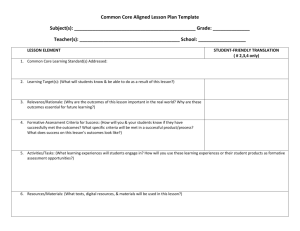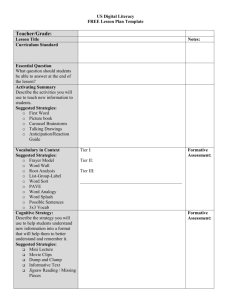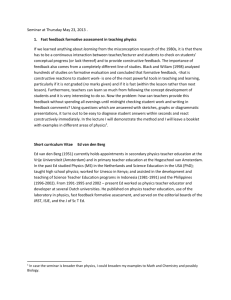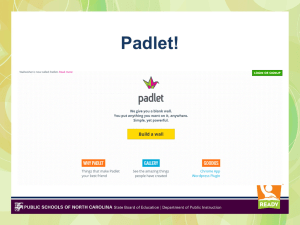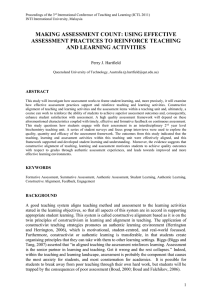Component: Characteristics of the Instructional Core
advertisement
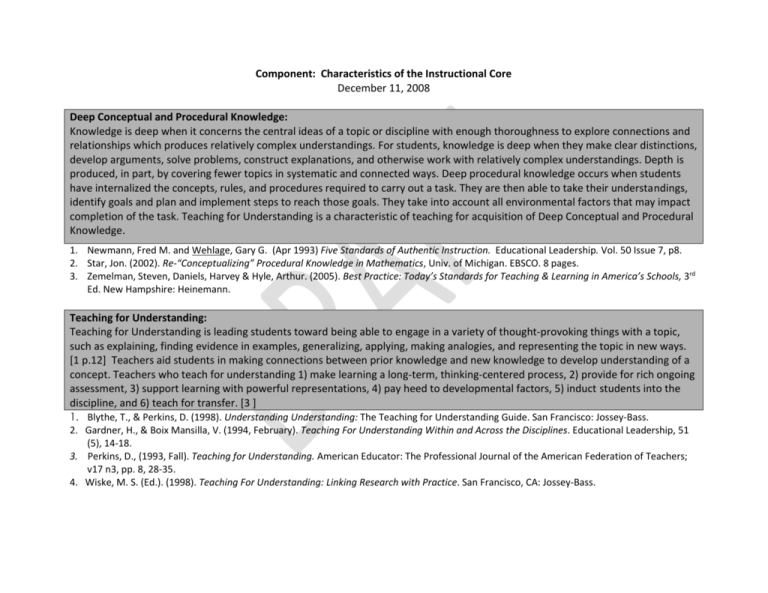
Component: Characteristics of the Instructional Core December 11, 2008 Deep Conceptual and Procedural Knowledge: Knowledge is deep when it concerns the central ideas of a topic or discipline with enough thoroughness to explore connections and relationships which produces relatively complex understandings. For students, knowledge is deep when they make clear distinctions, develop arguments, solve problems, construct explanations, and otherwise work with relatively complex understandings. Depth is produced, in part, by covering fewer topics in systematic and connected ways. Deep procedural knowledge occurs when students have internalized the concepts, rules, and procedures required to carry out a task. They are then able to take their understandings, identify goals and plan and implement steps to reach those goals. They take into account all environmental factors that may impact completion of the task. Teaching for Understanding is a characteristic of teaching for acquisition of Deep Conceptual and Procedural Knowledge. 1. Newmann, Fred M. and Wehlage, Gary G. (Apr 1993) Five Standards of Authentic Instruction. Educational Leadership. Vol. 50 Issue 7, p8. 2. Star, Jon. (2002). Re-“Conceptualizing” Procedural Knowledge in Mathematics, Univ. of Michigan. EBSCO. 8 pages. 3. Zemelman, Steven, Daniels, Harvey & Hyle, Arthur. (2005). Best Practice: Today’s Standards for Teaching & Learning in America’s Schools, 3rd Ed. New Hampshire: Heinemann. Teaching for Understanding: Teaching for Understanding is leading students toward being able to engage in a variety of thought-provoking things with a topic, such as explaining, finding evidence in examples, generalizing, applying, making analogies, and representing the topic in new ways. [1 p.12] Teachers aid students in making connections between prior knowledge and new knowledge to develop understanding of a concept. Teachers who teach for understanding 1) make learning a long-term, thinking-centered process, 2) provide for rich ongoing assessment, 3) support learning with powerful representations, 4) pay heed to developmental factors, 5) induct students into the discipline, and 6) teach for transfer. [3 ] 1. Blythe, T., & Perkins, D. (1998). Understanding Understanding: The Teaching for Understanding Guide. San Francisco: Jossey-Bass. 2. Gardner, H., & Boix Mansilla, V. (1994, February). Teaching For Understanding Within and Across the Disciplines. Educational Leadership, 51 (5), 14-18. 3. Perkins, D., (1993, Fall). Teaching for Understanding. American Educator: The Professional Journal of the American Federation of Teachers; v17 n3, pp. 8, 28-35. 4. Wiske, M. S. (Ed.). (1998). Teaching For Understanding: Linking Research with Practice. San Francisco, CA: Jossey-Bass. Student Centered Classrooms: In Student Centered Classrooms, students construct their own knowledge based on experiential, holistic, authentic, and challenging experiences. Teachers take the skills, knowledge, and concepts that the curriculum requires and infuses them in what students want to learn. Teachers encourage students to reflect on their own thinking and learning. Curriculum and assessments are centered on meaningful performances in real-world contexts. Classrooms are organized for collaboration. A student centered classroom is a characteristic of Teaching through Problem Solving, Teaching through Inquiry, and Teaching through Inductive Thinking. 1. David, Jane L, “What Research Says About Project-Based Learning,” Educational Leadership, ASCD, Feb. 2008. 2. Tomlinson, Carol and Jane Jarvis, “Teaching Beyond the Book,” Educational Leadership, ASCD, Sept. 2006. 3. Zemelman, Steven, Daniels, Harvey & Hyle, Arthur. (2005). Best Practice: Today’s Standards for Teaching & Learning in America’s Schools, 3rd Ed. New Hampshire: Heinemann Rigorous and Relevant Curriculum: Rigor and Relevance is represented by challenging content that is significant to a topic and includes authentic work. It involves original application of knowledge and skills to complex problems (Construction of Knowledge) rather than just routine use of facts and procedures. It also entails the use of prior knowledge, the development of in-depth understanding, and the ability to develop and express ideas and findings through elaborated communication. It engages students in interpreting, analyzing, synthesizing, evaluating concepts, and produces an authentic product (Disciplined Inquiry). The content is not just interesting to students, but involves a particular intellectual challenge. When students successfully meet these challenges, their new learning will have meaning and value in contexts outside of the classroom (Value Beyond the Classroom). They incorporate and internalize these new learnings into their lives. Rigor and Relevance are both characteristics of Teaching through Problem Solving, Teaching through Inquiry, and Teaching through Inductive Thinking. 1. Newmann, F.M., B. M. King, and D. L. Carmichael, (2007). “Authentic Instruction and Assessment: Common Standards for Rigor and Relevance in Teaching Academic Subjects”. Des Moines, IA: Iowa Dept. of Education. 2. Rigor and Relevance Handbook (2002). Rexford, New York: International Center for Leadership in Education. Assessment FOR Learning (Formative Assessment): Formative assessment is a process used by teachers and students as part of instruction that provides feedback to adjust ongoing teaching and learning to improve students’ achievement of core content. As assessment FOR learning, formative assessment practices provide students with clear learning targets, examples and models of strong and weak work, regular descriptive feedback, and the ability to self-assess, track learning, and set goals. (Adapted from Council of Chief State School Officers, FAST SCASS). Assessment for Learning is a characteristic of Teaching through Problem Solving, Teaching through Inquiry, and Teaching through Inductive Thinking. 1. Black, P., & Wiliam, D., (1998) “Inside the Black Box: Raising Standards through Classroom Assessment”. Phi Delta Kappan, v80 n2 p139-44 Oct 1998. 2. Chappuis, J., (2005) “Helping Students Understand Assessment”. Educational Leadership, Nov2005, Vol. 63 Issue 3, p39-43, 5p, 1 chart, 2bw. 3. Heritage, Margaret. “Formative Assessment: What Do Teachers Need to Know and Do?” Phi Delta Kappan, v89 n2 p140-145 Oct 2007. 6pp. 4. Heritage, Margaret (2008). “Learning Progressions: Supporting Instruction and Formative Assessment”. Washington D.C.: The Council of Chief State School Officers. 5. Stiggins, R., (2007). “Assessment through the Student’s Eye”. Educational Leadership May2007, Vol. 64 Issue 8, p22-26, 5p. 6. Stiggins, R., (2007) “Five Assessment Myths and Their Consequences”. Education Week, v27, n8, p28-29 Oct 2007. 7. Stiggins, R., (2005). “From Formative Assessment To Assessment for Learning: A Path to Success in Standards-Based Schools”. Phi Delta Kappan, Dec. 2005, Vol. 87 Issue 4, p324-328, 5p, 1bw. 8. “The Value of Formative Assessment”. The National Center for Fair & Open Testing Journal, Fair Test Examiner on the value of Formative Assessment. Teaching for Learner Differences: Teaching for Learner Differences requires teachers to understand the core concepts and essential skills, understand the contributing factors affecting the desired outcome, and have a variety of methods to present and reinforce the desired skills. It includes providing access to the general education curriculum through Universal Design for Learning (CAST) and Differentiated Instruction planning (Tomlinson), as well as, utilizing strategies and routines supported by the Department of Education such as Teaching through Inquiry, Teaching through Problem Solving, and Teaching through Inductive Thinking. Teaching for Learner Differences can best be accomplished by engaging in the Instructional Decision Making process which has teachers using student and instructional assessment data to make sound instructional decisions to meet the needs of individual students. 1. Rose, David H. and Anne Meyer, editors (2006). A Practical Reader in Universal Design for Learning. Center for Applied Special Technology (CAST), Harvard Education Press, Boston, MA. 2. Tomlinson, C. A. (2001). How to Differentiate Instruction in Mixed-Ability Classrooms. (2nd Ed.) Alexandria, VA: ASCD.
